High-Resolution Bathymetric Survey and Updated Morphometric Analysis of Lake Markakol (Kazakhstan)
Abstract
1. Introduction
2. Materials and Methods
3. Results
3.1. Digitization and Creation of a Three-Dimensional Model of the Lake Based on Archival Data
3.2. Chart of Transects for Depth Measurement
- Survey area boundaries: The shoreline of the lake was delineated using satellite imagery, which served as the reference boundary for transect design.
- Coordinate grid system: The WGS 1984 global coordinate system was adopted, with the option for conversion to the Universal Transverse Mercator (UTM) rectangular coordinate system, to align with the use of satellite-based geospatial data.
- Transect spacing: Given that the survey was conducted for scientific purposes, and in accordance with SP RK 1.02-101-2014 Kazakh National Code [27], reconnaissance and light hydrographic works were planned. In such works, depth measurements are typically performed along a sparse transect grid using simplified horizontal positioning techniques. Consequently, a spacing of 500 m between transects was selected for this study [28,29,30].
3.3. Field Works and Data Acquisition
- Depth measurement using an echo sounder;
- Depth measurement using a rod or hand lead line;
- Depth measurement using a mechanical lead line equipped with a hydrometric weight and a graduated crane.
- Display: SolarMax HD, 12-inch screen, 1280 × 800 resolution, multi-touch interface (Lowrance Electronics, Tulsa, Oklahoma, USA);
- Echo sounder: Active Imaging 3-in-1 with StructureScan 3D and LiveSight transducer support;
- Transducer: Active Imaging 3-in-1 included;
- Maximum depth range: 305 m (CHIRP); 91 m (DownScan and SideScan);
- Power supply: 12 VDC (operational range 10.8–17 VDC);
- GPS module: 16-channel, 10 Hz built-in GPS receiver;
- Mapping support: Compatible with Navionics and C-MAP;
- Memory capacity: 100 tracks, 3000 waypoints, 100 routes.
3.4. Desktop Work and Geostatistical Analysis
- Delineation and vectorization of the lake shoreline;
- Construction of the bathymetric map;
- Geostatistical analysis of the bathymetric data;
- Determination of bathygraphic curve coordinates;
- Calculation of the lake’s morphometric characteristics.
3.5. Morphometric Change Analysis
- Conversion of the completed isobaths into polygon objects;
- Assignment of depth values to each polygon layer;
- Calculation of water volume and surface area.
4. Discussion
4.1. Comparison to Historical Data
4.2. Methodological Limitations
4.3. Ecological Implications
4.4. Potential Drivers of Observed Changes
5. Conclusions
Supplementary Materials
Author Contributions
Funding
Data Availability Statement
Acknowledgments
Conflicts of Interest
References
- Naumenko, M.A. A new estimation of morphometric characteristics of Lake Onega. Rep. Acad. Sci. 2000, 370, 393–396. [Google Scholar]
- Zlinsky, A.; Molnar, G. Georeferencing the First Bathymetric Maps of Lake Balaton, Hungary. Acta Geod. Geoph. Hung. 2009, 44, 79–94. [Google Scholar] [CrossRef][Green Version]
- Vereshchagin, G.Y. Methods of morphometric characteristics of lakes. In Proceedings of the Olonets Scientific Expedition; Book 2, Russian Hydrological Institute: Leningrad, Russia, 1930; Volume 1, p. 106. [Google Scholar][Green Version]
- Li, Z.; Zhu, C.; Gold, C. Digital Terrain Modeling: Principles and Methodology, 1st ed.; CRC Press: Boca Raton, FL, USA, 2004. [Google Scholar] [CrossRef]
- Caballero, I.; Stumpf, R.P. On the use of Sentinel-2 satellites and lidar surveys for the change detection of shallow bathymetry: The case study of North Carolina inlets. Coast. Eng. 2021, 169, 103936. [Google Scholar] [CrossRef]
- Hossen, H.; Khairy, M.; Ghaly, S.; Scozzari, A.; Negm, A.; Elsahabi, M. Bathymetric and Capacity Relationships Based on Sentinel-3 Mission Data for Aswan High Dam Lake, Egypt. Water 2022, 14, 711. [Google Scholar] [CrossRef]
- Sundt, H.; Alfredsen, K.; Museth, J.; Forseth, T. Combining green LiDAR bathymetry, aerial images and telemetry data to derive mesoscale habitat characteristics for European grayling and brown trout in a Norwegian river. Hydrobiologia 2022, 849, 509–525. [Google Scholar] [CrossRef]
- Kaya, Y.; Balik Sanli, F.; Abdikan, S. Refinement of ICESat-2 derived inland water surface levels with the TG20 local geoid model: In the case of Türkiye lakes. Phys. Chem. Earth Parts A/B/C 2025, 139, 103900. [Google Scholar] [CrossRef]
- Xu, N.; Zheng, H.; Ma, Y.; Yang, J.; Liu, X.; Wang, X. Global Estimation and Assessment of Monthly Lake/Reservoir Water Level Changes Using ICESat-2 ATL13 Products. Remote Sens. 2021, 13, 2744. [Google Scholar] [CrossRef]
- Database Update: NH Bathymetry—Lakes. Available online: https://www.nhgeodata.unh.edu/search?q=bathymetry (accessed on 15 August 2025).
- Guan, J.; Zhang, H.; Han, T.; Cao, W.; Wang, J.; Li, D. High-Resolution Mapping of Shallow Water Bathymetry Based on the Scale-Invariant Effect Using Sentinel-2 and GF-1 Satellite Remote Sensing Data. Remote Sens. 2025, 17, 640. [Google Scholar] [CrossRef]
- Li, Z.; Peng, Z.; Zhang, Z.; Chu, Y.; Xu, C.; Yao, S.; Garcia-Fernandez, A.; Zhu, X.; Yue, Y.; Levers, A.; et al. Exploring modern bathymetry: A comprehensive review of data acquisition devices, model accuracy, and interpolation techniques for enhanced underwater mapping. Front. Mar. Sci. Sec. Ocean Obs. 2023, 10, 1178845. [Google Scholar] [CrossRef]
- Li, J.; Dong, Z.; Chen, L.; Tang, Q.; Hao, J.; Zhang, Y. Multi-Temporal Image Fusion-Based Shallow-Water Bathymetry Inversion Method Using Active and Passive Satellite Remote Sensing Data. Remote Sens. 2025, 17, 265. [Google Scholar] [CrossRef]
- Seafloor Mapping. Available online: https://www.ncei.noaa.gov/products/seafloor-mapping?utm_source=chatgpt.com (accessed on 15 August 2025).
- Xie, C.; Chen, P.; Zhang, S.; Huang, H. Nearshore Bathymetry from ICESat-2 LiDAR and Sentinel-2 Imagery Datasets Using Physics-Informed CNN. Remote Sens. 2024, 16, 511. [Google Scholar] [CrossRef]
- Yeu, Y.; Yee, J.-J.; Yun, H.S.; Kim, K.B. Evaluation of the Accuracy of Bathymetry on the Nearshore Coastlines of Western Korea from Satellite Altimetry, Multi-Beam, and Airborne Bathymetric LiDAR. Sensors 2018, 18, 2926. [Google Scholar] [CrossRef]
- Kaya, Y. Evaluation of ICESat-2 Laser Altimetry for Inland Water Level Monitoring: A Case Study of Canadian Lakes. Water 2025, 17, 1098. [Google Scholar] [CrossRef]
- Great Lakes Bathymetry. Available online: https://www.ncei.noaa.gov/products/great-lakes-bathymetry?utm_source=chatgpt.com (accessed on 28 August 2025).
- Khare, N.; Chaturvedi, S.K.; Saraswat, R.; Srivastava, R.; Raina, R.; Wanganeo, A. Some morphometric characteristics of Priyadarshini water body at Schirmacher Oasis, Central Dronning Maud Land, Antartica with special reference to its bathymetry. Indian J. Mar. Sci. 2008, 37, 438. [Google Scholar]
- Basos, N.; Martins, F.; Rodrigues, J. Bathymetry interpolation for hydrodynamic modelling. Lisboa 2014, 24, 25–26. [Google Scholar]
- Nishikanth, C.V.; Vasudevan, S.; Balamurugan, P.; Selvaganapathi, R. Morphometry Characteristics Delineation and Bathymetry Mapping of Lake Dal, Kashmir valley, India using Geospatial Techniques. Int. J. Multidiscip. 2018, 3, 216–220. [Google Scholar] [CrossRef]
- Sherstyankin, P.P.; Alekseev, S.P.; Abramov, A.M.; Stavrov, K.G.; De Batist, M.; Hus, R.; Canals, M.; Casamor, J.L. Computer-based bathymetric map of Lake Baikal. Dokl. Earth Sci. 2006, 408, 564–569. [Google Scholar] [CrossRef]
- Astashin, A.; Badin, M.; Vatina, O.; Podkovyrina, V.; Il’ichyova, E. Morphometric characteristics of the Krasnyj Klyuch lake Complex (Republic of Bashkortostan, Russia). Water Resour. Aquat. Ecosyst. 2023, 431, 04005. [Google Scholar] [CrossRef]
- Rout, S.V.; Sivaprakasam, S.; Krishna, K. Lake Bathymetry Survey and Morphometric Characteristics of High Altitude Lake the Chandratal in Western Himalaya. J. Crit. Rev. 2021, 7, 4615–4625. Available online: https://www.researchgate.net/publication/350276417 (accessed on 28 August 2025).
- Tursunov, E.A.; Madibekov, A.S.; Ranova, S.U.; Galaeva, A.V. Modern bathygraphic characteristics of Kapshagai reservoir. Sci. J. “Hydrometeorol. Ecol.” Almaty 2014, 2, 105–110. [Google Scholar]
- Tursunov, E.A.; Madibekov, A.S.; Kulebaev, K.M. Modern morphometric characteristics of Lake Balkhash. In Scientific Notes of the Russian State Hydrometeorological University; special issue dedicated to the 80th anniversary of Prof. Dr. Doganovsky A.M.; RGGMU Press: Saints-Peterburg, Russia, 2014; pp. 43–48. (In Russian) [Google Scholar]
- SP RK 1.02-101-2014 Engineering-geodetic surveys for constructionBasic provisions. Committee for Construction, Housing and Utilities, and Land Resources Management, Ministry of National Economy of the Republic of Kazakhstan. Astana, Kazakhstan, 2015. (In Russian). Available online: https://igis.kz/images/snip/ntd-geodez-izyskaniya/sp-rk-1.02-101-2014-inzh-geodezich-izyskaniya-dlya-stroitelstva-osnovnye-polozheniya.pdf (accessed on 28 August 2025).
- Bykov, V.D.; Vasiliev, A.V. Hydrometry; Publishing Hydrometeoizdat: Leningrad, Russia, 1972; p. 447. (In Russian) [Google Scholar]
- Samokhin, A.A.; Soloviyev, N.N.; Doganovsky, A.M. Practicum on Hydrology; Hydrometeoizdat: Leningrad, Russia, 1980; p. 296. (In Russian) [Google Scholar]
- SP RK 1.02-105-2014 Engineering Surveys for Construction. Basic Provisions. (with Amendments and Additions from 02.02.2024). Available online: https://online.zakon.kz/Document/?doc_id=31848779 (accessed on 9 February 2024).
- SP RK 1.02-101-2014 Engineering-Geodetic Surveys for Construction. Basic Provisions. Available online: https://online.zakon.kz/Document/?doc_id=38117869 (accessed on 1 February 2024).
- SN RK 1.03-03-2013 Geodetic Works in Construction. State Regulations in the Field of Architecture, Urban Planning and Construction. Construction Norms of the Republic of Kazakhstan. Ministry of National Economy of the Republic of Kazakhstan. Date of Introduction—2015-07-01. Available online: https://online.zakon.kz/Document/?doc_id=34849777 (accessed on 9 February 2024).
- Azizian, A.; Shokoohi, A. Investigation of the Effects of DEM Creation Methods on the Performance of a Semidistributed Model: TOPMODEL. J. Hydrol. Eng. 2015, 20, 05015005. [Google Scholar] [CrossRef]
- Zhu, S.; Liu, B.; Wan, W.; Xie, H.; Fang, Y.; Chen, X.; Li, H.; Fang, W.; Zhang, G.; Tao, M.; et al. A new digital lake bathymetry model using the step-wise water recession method to generate 3D lake bathymetric maps based on DEMs. Water 2019, 11, 2419. [Google Scholar] [CrossRef]
- Xiao, Y.; Wang, G.; Zhao, H.; Wang, J.; Qiao, B. Estimation of Lake Storage Based on the Surrounding Topography around the Lake from the SRTM DEM. Water 2023, 15, 1015. [Google Scholar] [CrossRef]
- Bogoslovsky, B. Limnology (in Russian: Ozerovedenie); Moscow State University Publishing House: Moscow, Russia, 1960; p. 335. [Google Scholar]
- Kunz, M.; Skowron, R.; Skowroński, S. Morphometry Changes of Lake Ostrowskie (the Gniezno Lakeland) on the Basis of Cartographic, Remote Sensing and Geodetic Surveying. Limnol. Rev. 2010, 10, 77–85. [Google Scholar] [CrossRef]
- Abebe, Y.; Bitew, M.; Ayenew, T.; Alo, C.; Cherinet, A.; Dadi, M. Morphometric Change Detection of Lake Hawassa in the Ethiopian Rift Valley. Water 2018, 10, 625. [Google Scholar] [CrossRef]
- Perivolioti, T.-M.; Mouratidis, A.; Terzopoulos, D.; Kalaitzis, P.; Ampatzidis, D.; Tušer, M.; Frouzova, J.; Bobori, D. Production, Validation and Morphometric Analysis of a Digital Terrain Model for Lake Trichonis Using Geospatial Technologies and Hydroacoustics. ISPRS Int. J. Geo-Inf. 2021, 10, 91. [Google Scholar] [CrossRef]
- Choiński, A.; Zieliński, A. Transformation of the Morphometry of Lake Osieckie—Largest Lake in the Holy Cross Region. Limnol. Rev. 2021, 21, 181–187. [Google Scholar] [CrossRef]
- Šakurova, I.; Kondrat, V.; Baltranaitė, E.; Vasiliauskienė, E.; Kelpšaitė-Rimkienė, L. Assessment of Coastal Morphology on the South-Eastern Baltic Sea Coast: The Case of Lithuania. Water 2023, 15, 79. [Google Scholar] [CrossRef]
- Trimble® Business Center Office Software Is Ideal for Processing and Analyzing GNSS and Terrestrial (Total Station and Level) Survey Data Ecorded in the Field, and Exporting It to a Design Package. Available online: https://mytrimbleprotected.com/knowledge/docushare/retrieve?handle=File-503698 (accessed on 9 February 2024).
- LOWRANCE HDS-12 Live User Manual. Available online: https://www.manua.ls/lowrance/hds-live-12/manual?p=2 (accessed on 2 February 2024).
- ReefMaster User Manual v1.6; Copyright © 2014; ReefMaster Software Limited: Chichester, UK, 2014; p. 210.
- Michael, L. Getting to Know Arcgis Desktop/Law Michael, 3; Esri Press: New York, NY, USA, 2012; p. 856. [Google Scholar]
- Maribeth, P. Mastering ArcGIS/Price Maribeth. 7; McGraw-Hill Education: New York, NY, USA, 2015; p. 624. [Google Scholar]
- Michael, L. Getting to Know ArcGIS® Pro/Law Michael, Collins Amy. 3; Esri Press: New York, NY, USA, 2016; p. 450. [Google Scholar]
- Yan, Y.; Xiao, F.; Du, Y. Construction of lake bathymetry from MODIS satellite data and GIS from 2003 to 2011. Chin. J. Oceanol. Limnol. 2014, 32, 720–731. [Google Scholar] [CrossRef]
- GKINP (GNTA)-08-003-07 Basic Provisions on Creation and Updating of Topographic Maps at Scales 1:10 000, 1:25 000, 1:50 000, 1:100 000, 1:200 000, 1:500 000, 1:1 000 000. Agency of the Republic of Kazakhstan for Land Resources Management. Geodesic, Cartographic Instructions Norms and Rules. Approved by the Order of the Agency of the Republic of Kazakhstan for Land Resources Management Dated December 25, 2007, No. 200-P. Available online: https://online.zakon.kz/Document/?doc_id=32757121&show_di=1 (accessed on 2 February 2024).
- GKINP (GNTA)-02-028-09 Instruction on Topographic Survey at Scales of 1:5,000, 1:2,000, 1:1,000, 1:500. Agency of the Republic of Kazakhstan for Land Resources Management. Geodesic, Cartographic Instructions Norms and Rules. Astana 2009. Approved by the Order of the Agency of the Republic of Kazakhstan for Land Resources Management Dated December 15, 2009, No. 222-P. Available online: https://online.zakon.kz/Document/?doc_id=32904792&pos=4;-49#pos=4;-49 (accessed on 28 August 2025).
- Conditional Signs for Topographic Plans of Scale 1:5000, 1:2000, 1:1000, 1:500, GUGK ((Main Directorate of Geodesy and Cartography), 1986. Available online: https://rkc56.ru/documents/762 (accessed on 28 August 2025).
- Instruction on Topographic Survey in Scales 1:5000–1:500, Edition 2009. Available online: https://online.zakon.kz/Document/?doc_id=32904792 (accessed on 2 February 2024).
- Walther, M.; Kamp, U.; Nandintsetseg, N.-O.; Dashtseren, A.; Temujin, K. Glacial Lakes of Mongolia. Geographies 2024, 4, 21–39. [Google Scholar] [CrossRef]
- Drakopoulou, P.; Panagiotopoulos, I.P.; de Michele, M.; Kapsimalis, V.; Raucoules, D.; Foumelis, M.; Morfis, I.; Livanos, I.; Sakellariou, D.; Vandarakis, D. Cross-Comparison of the “BathySent” Coastal Bathymetry to Sonar Measurements and Ratio Model Technique: Pilot Sites in the Aegean Sea (Greece). Water 2023, 15, 3168. [Google Scholar] [CrossRef]
- Rout, S.P.; Vasudevan, S.; Balamurugan, P. Assessment of textural characteristics and magnetic susceptibility to understand the sedimentation environment of the Chandratal Lake, Spiti Valley, Himachal Pradesh, India. Solid State Technol. 2021, 64, 2450–2468. [Google Scholar]
- Kowalczewska-Madura, K.; Dunalska, J.A.; Kutyła, S.; Kobus, S. Bottom sediments as an indicator of the restoration potential of lakes—A case study of a small, shallow lake under significant tourism pressure. Sci. Rep. 2024, 14, 13438. [Google Scholar] [CrossRef] [PubMed]
- Jia, X.; Huang, T.; Chen, M.; Han, N.; Liu, Y.; Chen, S.; Zhang, X. Distribution of Grazing Paths and Their Influence on Mountain Vegetation in the Traditional Grazing Area of the Tien-Shan Mountains. Remote Sens. 2023, 15, 3163. [Google Scholar] [CrossRef]
- Chen, F.; Zhang, M.; Guo, H.; Allen, S.; Kargel, J.S.; Haritashya, U.K.; Watson, C.S. Annual 30 m dataset for glacial lakes in High Mountain Asia from 2008 to 2017. Earth Syst. Sci. Data 2021, 13, 741–766. [Google Scholar] [CrossRef]
- Rakybaeva, A.A.; Dzhantasova, A.S.; Baimukanov, M.T. Towards assessment of the current state of zooplankton of Lake Markakol. Bull. KazNU Biol. Ser. Almaty 2011, 4, 98–102. [Google Scholar]
- Unified ecological Internet resource of the Ministry of Ecology, Geology and Natural Resources of the RK. National Reports of the Convention on Biodiversity Conservation. Fourth National Report of the Republic of Kazakhstan on Biological Diversity. 2008, p. 110. Available online: https://ecogosfond.kz/orhusskaja-konvencija/dostup-k-jekologicheskoj-informacii/jelektronnaja-baza-normativno-pravovyh-aktov-v-oblasti-ohrany-okruzhajushhej-sredy-i-prirodopolzovanija-jekoinfopravo/ (accessed on 28 August 2025).
- Proceedings of the Institute of Hydrobiology and Ecology. Volume II State of the Hydrobionts of Water Bodies of Specially Protected Natural Territories of Republican Importance of East Kazakhstan and Almaty Oblasts of Kazakhstan (Information-Analytical Manual). Part 2. Markakol State Nature Reserve; Institute of Hydrobiology and Ecology Publishing house: Almaty, Kazakhstan, 2017; p. 55. (In Russian) [Google Scholar]
- Baimukanov, M.T. History of fishing on Lake Markakol, problems of maturation of fish resources, fish gene pool and ways to solve them. In Proceedings of Markakol Reserve; Part 2; Institute of Hydrobiology and Ecology Publishing House: Ust-Kamenogorsk, Kazakhstan, 2009; Volume 1, pp. 90–101. [Google Scholar]
- Marcé, R.; George, G.; Buscarinu, P.; Deidda, M.; Dunalska, J.; Eyto, E.; Flaim, G.; Grossart, H.-P.; Istvanovics, V.; Lenhardt, M.; et al. Automatic High Frequency Monitoring for Improved Lake and Reservoir Management. Environ. Sci. Technol. 2016, 50, 10780–10794. [Google Scholar] [CrossRef] [PubMed]
- Hakanson, L. A Manual of Lake Morphometry; Springer: Berlin/Heidelberg, Germany, 1981; p. 477. [Google Scholar]
- Sandwell, D.T.; Smith, W.H. Bathymetric estimation. In Satellite Altimetry and Earth Sciences: A Handbook of Techniques and Applications; Fu, L.-L., Cazenave, A., Eds.; Academic Press: San Diego, CA, USA, 2000; pp. 441–457. [Google Scholar]
- Schäfer, A.E.; Marchett, C.A.; Schuh, S.M.; Ahlert, S.; Lanzer, R.M. Morphological characterization of eighteen lakes of the north and middle coast of Rio Grande do Sul, Brazil. Acta Limnol. Bras. 2014, 26, 199–214. [Google Scholar] [CrossRef][Green Version]
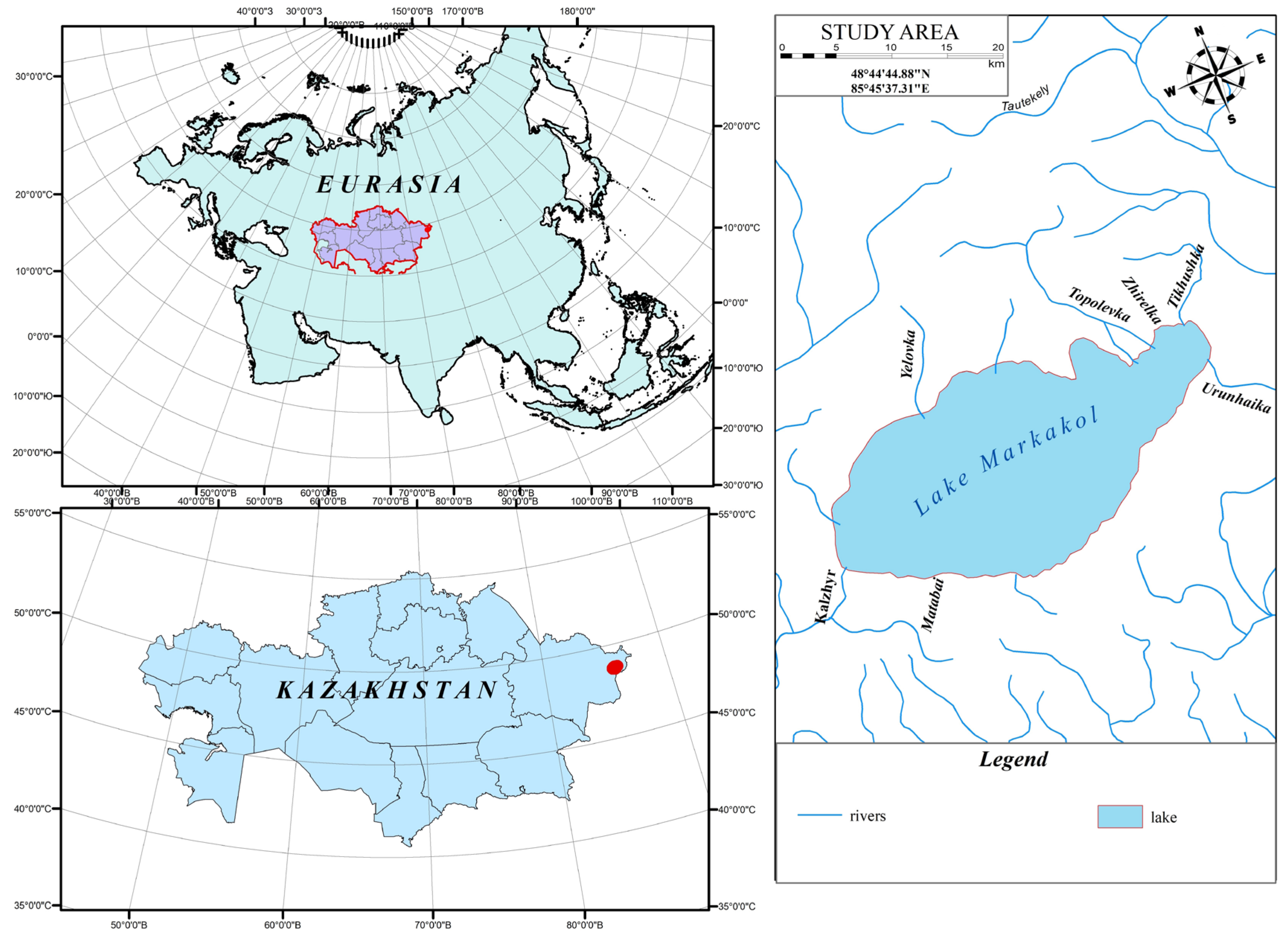
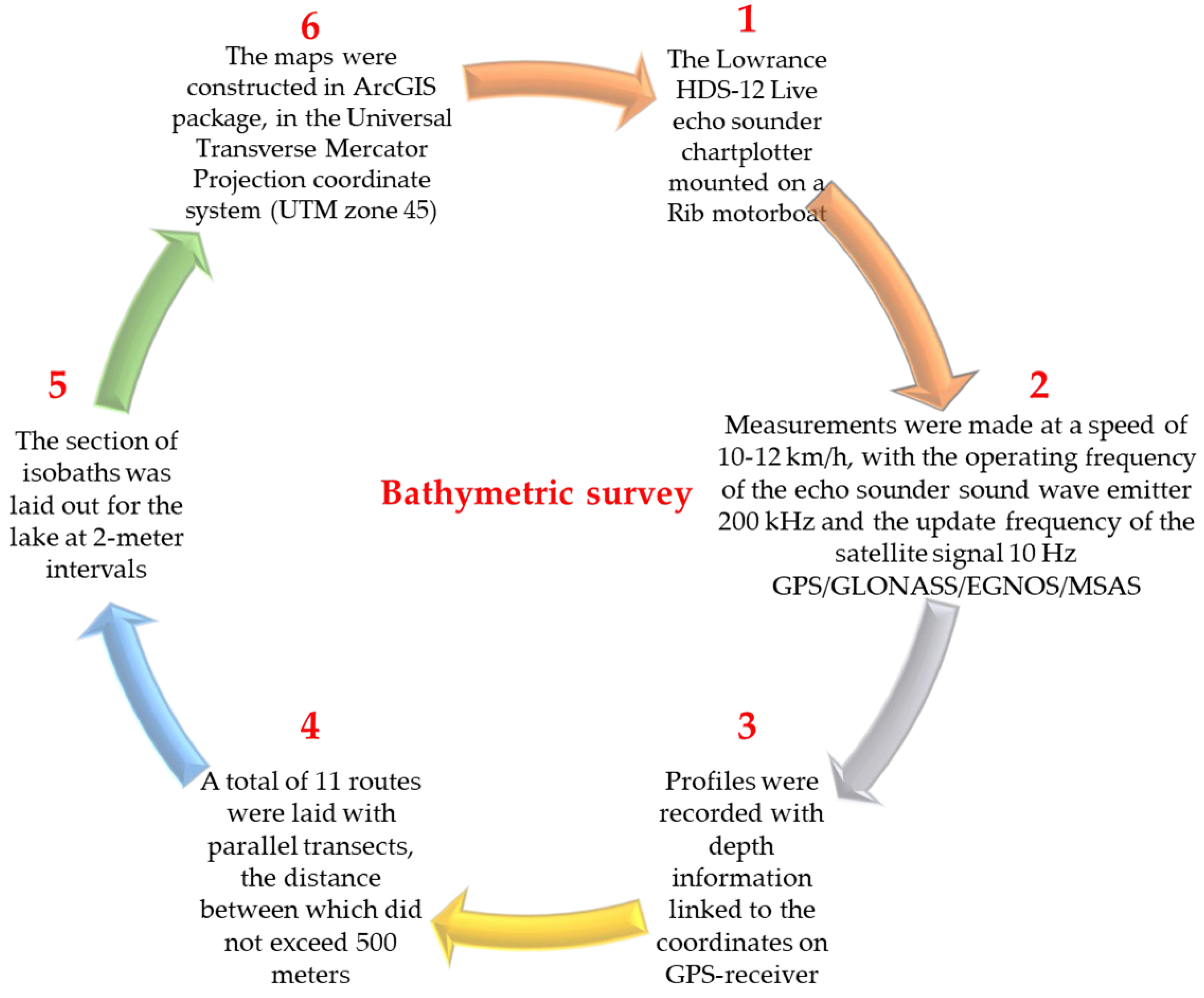
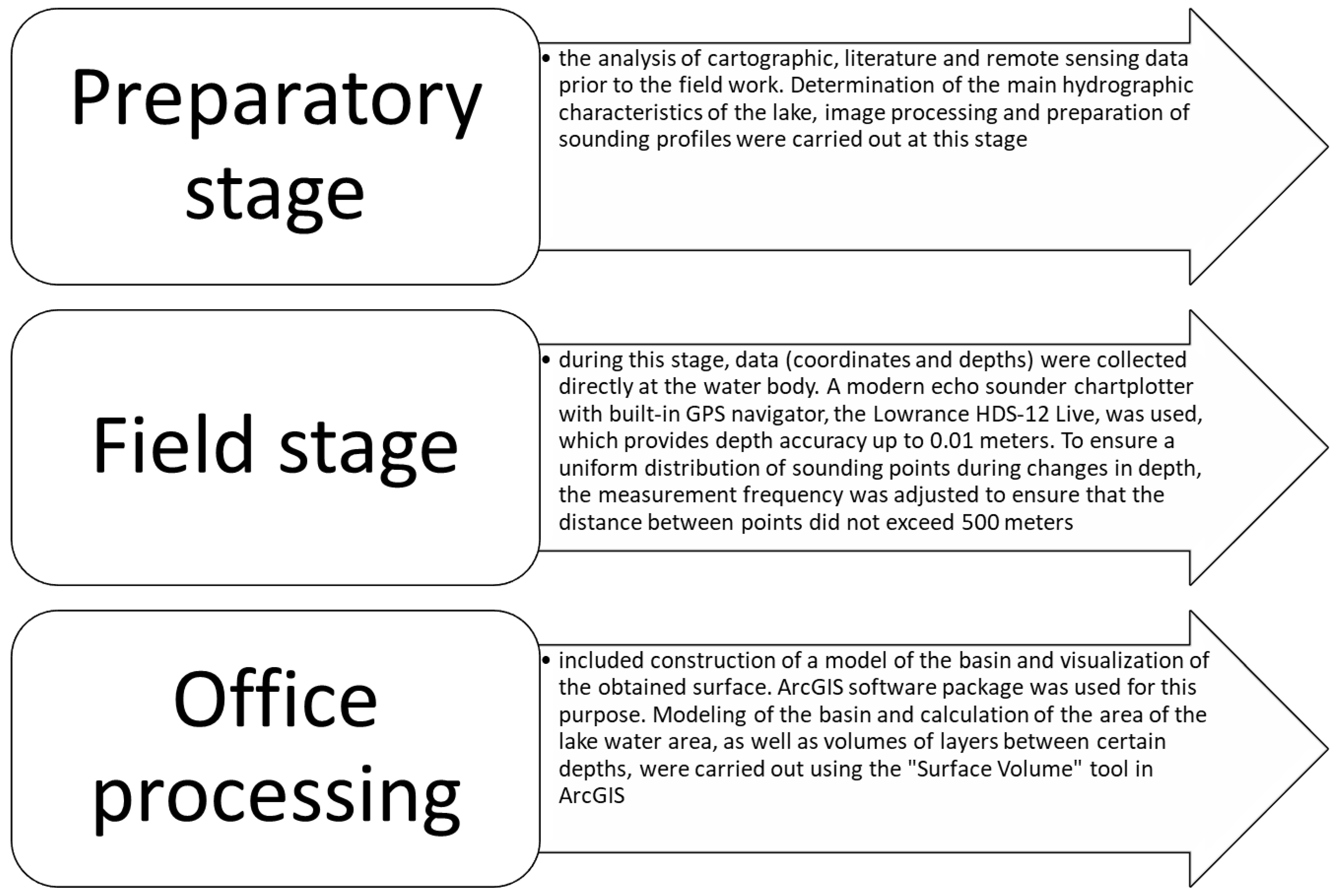
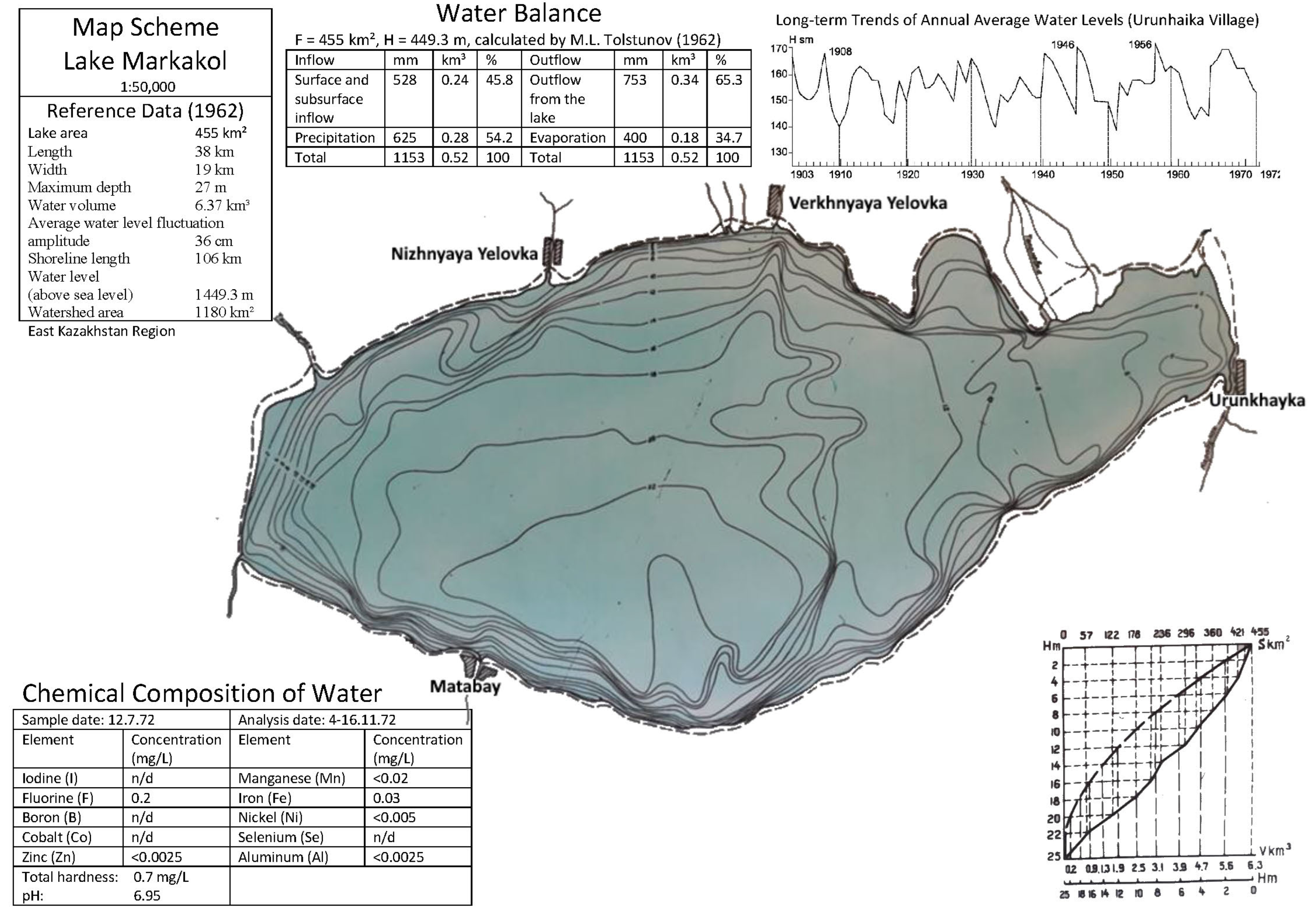
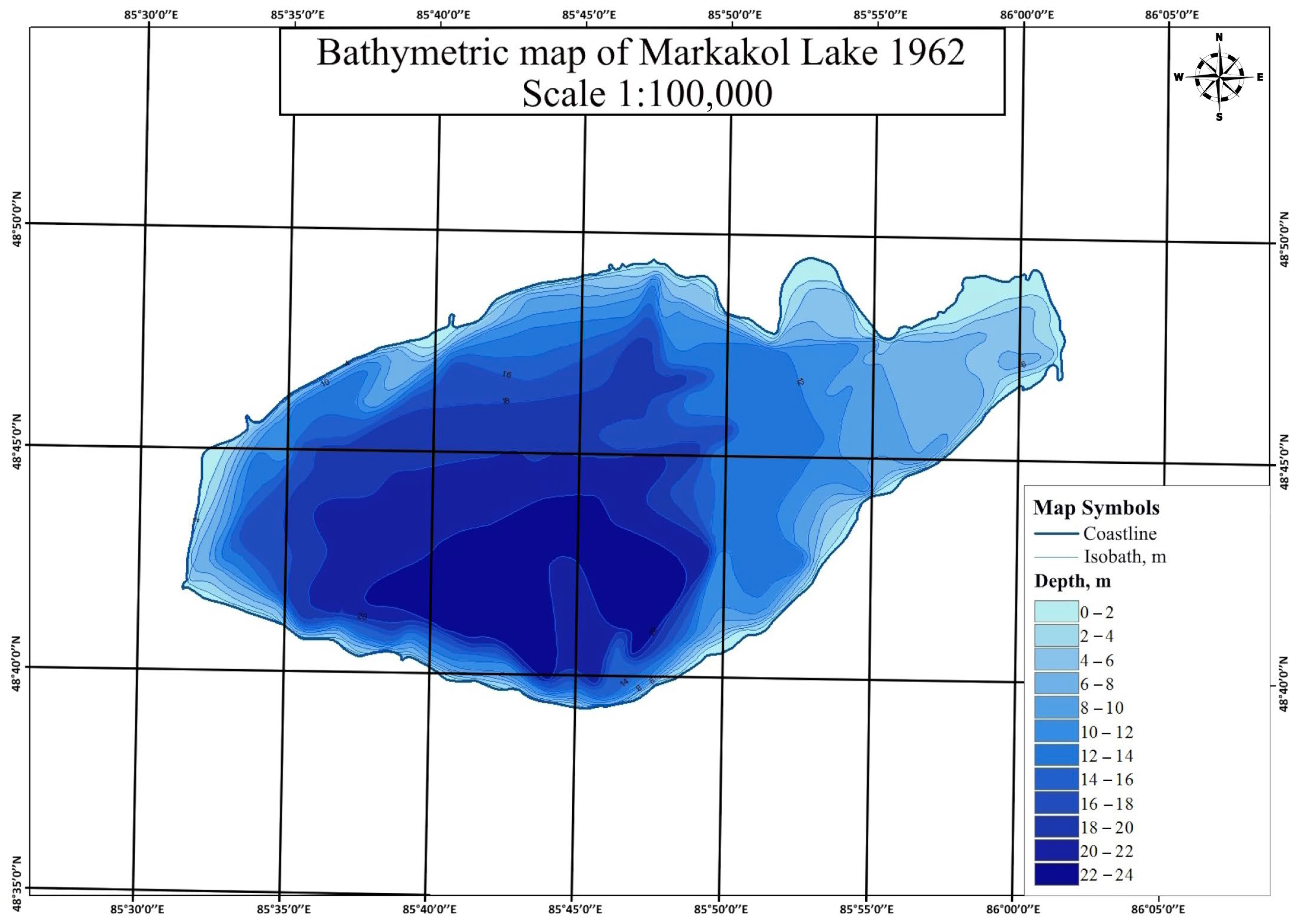

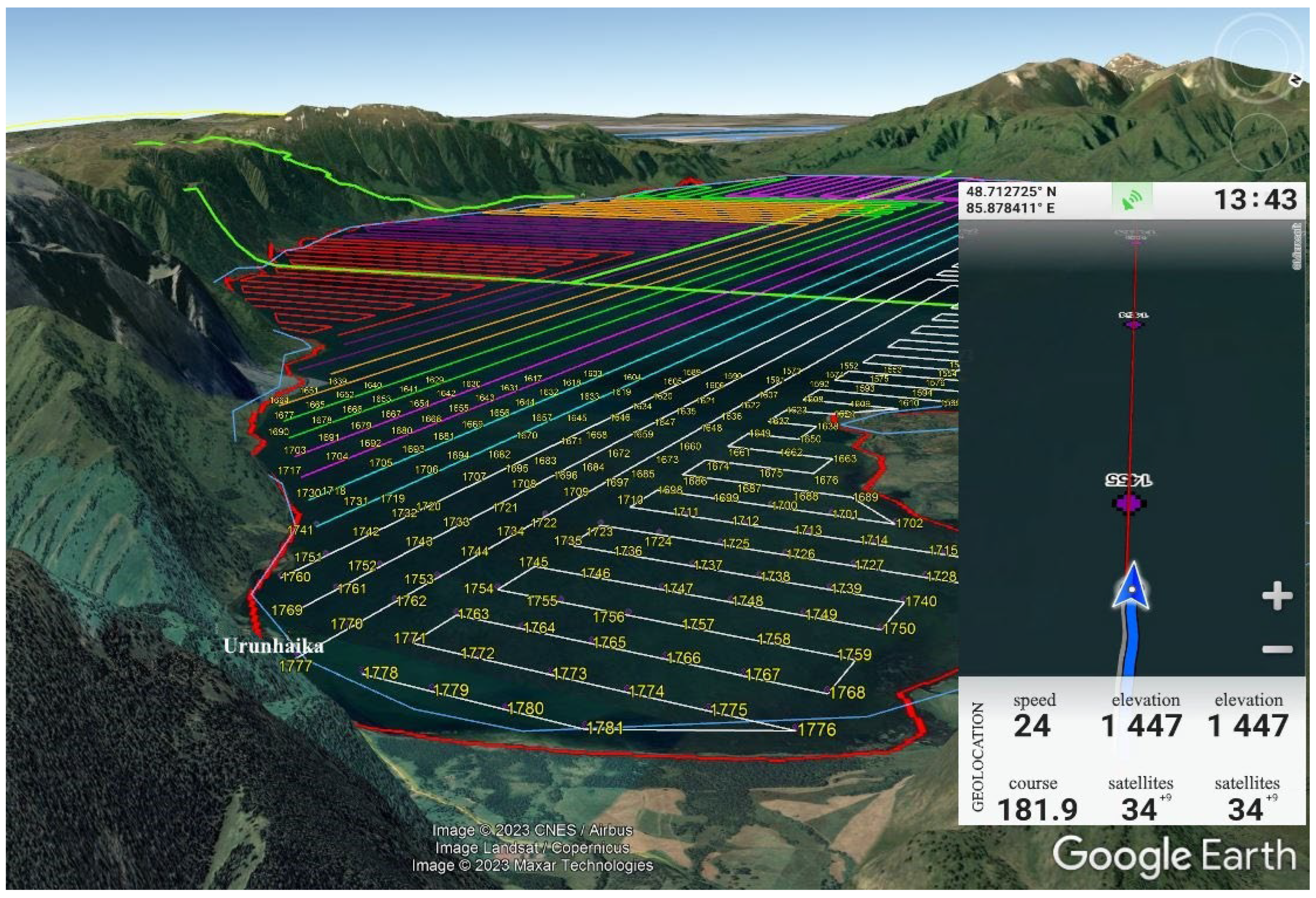
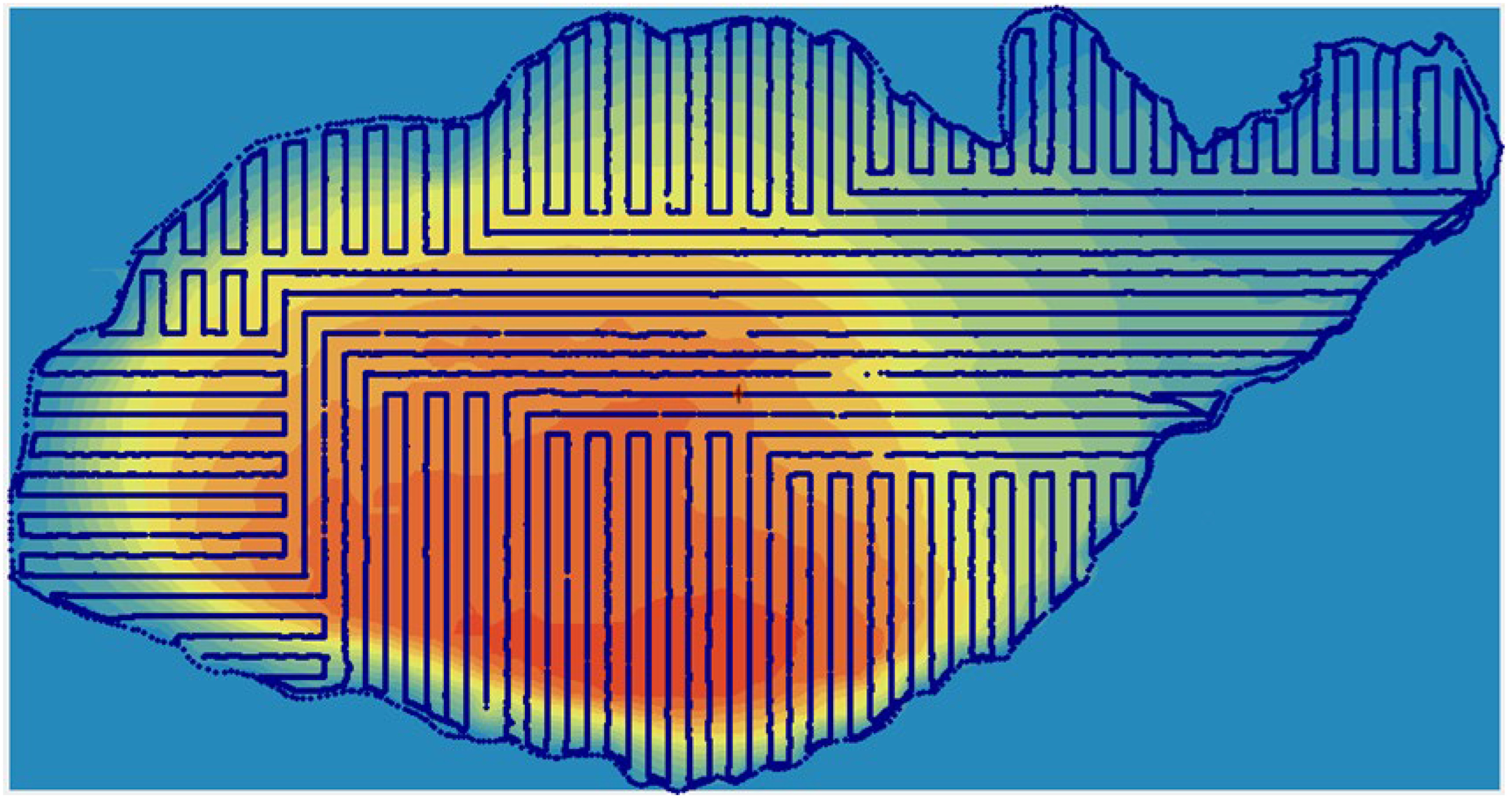

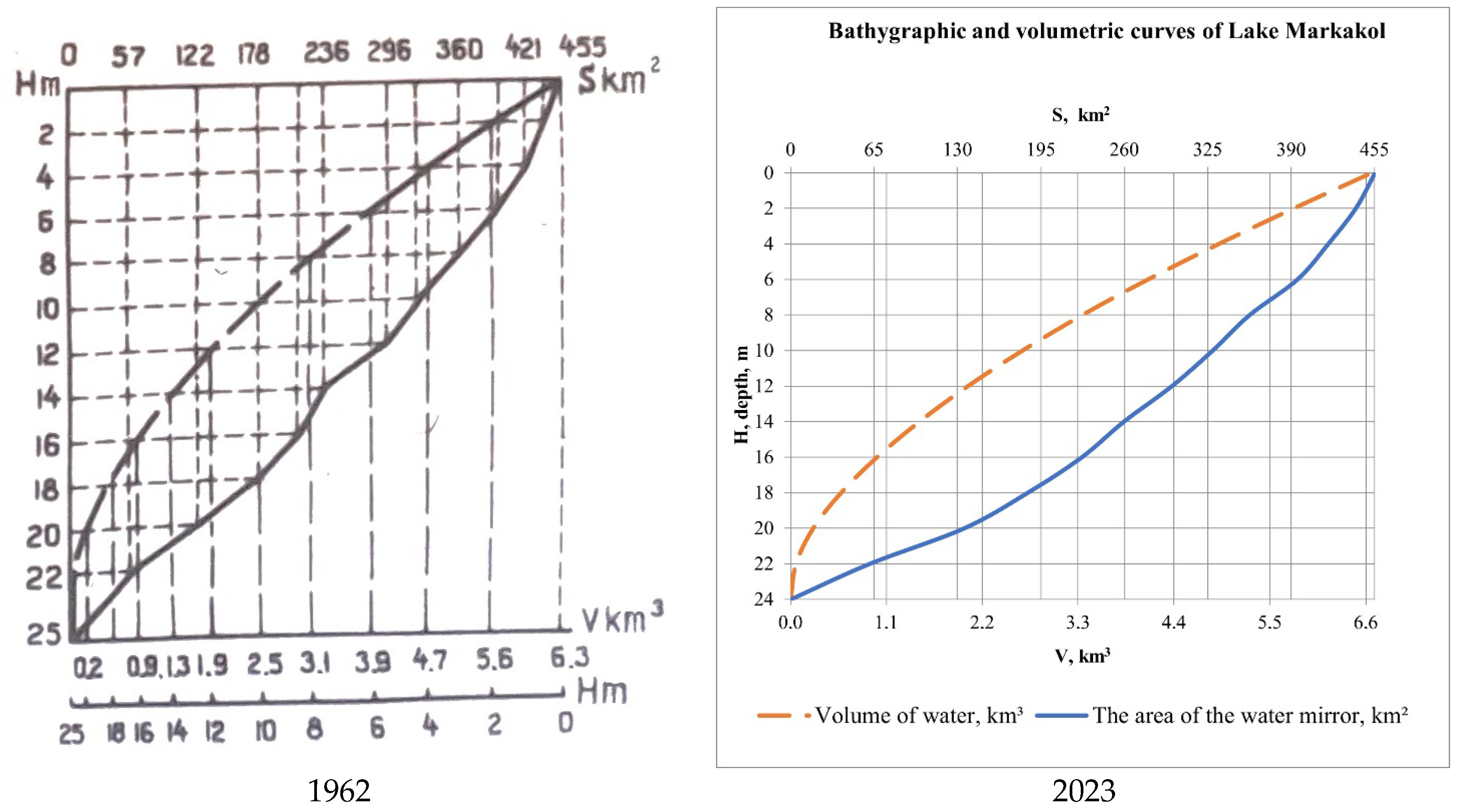
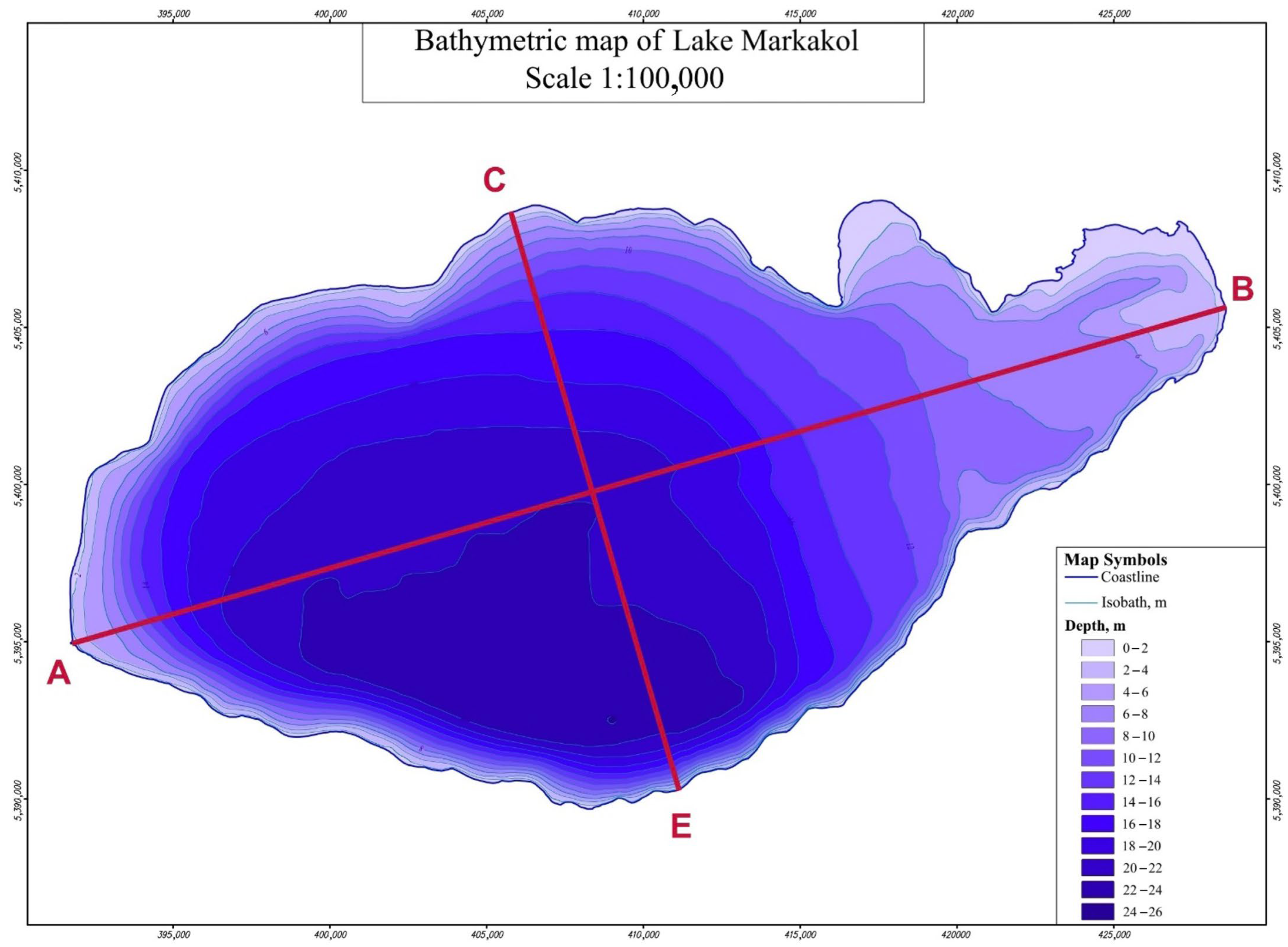

| Depth, m | Water Surface Area, km2 | Water Volume, km3 |
|---|---|---|
| 24 | 0 | 0.00 |
| 22 | 62 | 0.06 |
| 20 | 135 | 0.26 |
| 18 | 185 | 0.58 |
| 16 | 227 | 0.99 |
| 14 | 260 | 1.48 |
| 12 | 297 | 2.03 |
| 10 | 329 | 2.66 |
| 8 | 358 | 3.35 |
| 6 | 395 | 4.10 |
| 4 | 419 | 4.91 |
| 2 | 440 | 5.77 |
| 0 | 455 | 6.67 |
| Characteristics of the Lake | 1962 | 2023 (±Uncertainty) |
|---|---|---|
| Surface Area (km2) | 455.000 | 455.365 + 0.005 |
| Length (km) | 38.000 | 38.304 ± 0.002 |
| Width (km) | 19.000 | 19.138 ± 0.002 |
| Maximum depth (m) | 27.00 | 24.14 ± 0.17 |
| Water volume (km3) | 6.37 | 6.667 ± 0.025 |
| Shoreline length (km) | 106.00 | 103.559 ± 0.005 |
Disclaimer/Publisher’s Note: The statements, opinions and data contained in all publications are solely those of the individual author(s) and contributor(s) and not of MDPI and/or the editor(s). MDPI and/or the editor(s) disclaim responsibility for any injury to people or property resulting from any ideas, methods, instructions or products referred to in the content. |
© 2025 by the authors. Licensee MDPI, Basel, Switzerland. This article is an open access article distributed under the terms and conditions of the Creative Commons Attribution (CC BY) license (https://creativecommons.org/licenses/by/4.0/).
Share and Cite
Zhadi, A.; Madibekov, A.; Zhumatayev, S.; Ismukhanova, L.; Sultanbekova, B.; Zhumalipov, A.; Raimbekova, Z.; Rodrigo-Clavero, M.-E.; Rodrigo-Ilarri, J. High-Resolution Bathymetric Survey and Updated Morphometric Analysis of Lake Markakol (Kazakhstan). Hydrology 2025, 12, 228. https://doi.org/10.3390/hydrology12090228
Zhadi A, Madibekov A, Zhumatayev S, Ismukhanova L, Sultanbekova B, Zhumalipov A, Raimbekova Z, Rodrigo-Clavero M-E, Rodrigo-Ilarri J. High-Resolution Bathymetric Survey and Updated Morphometric Analysis of Lake Markakol (Kazakhstan). Hydrology. 2025; 12(9):228. https://doi.org/10.3390/hydrology12090228
Chicago/Turabian StyleZhadi, Askhat, Azamat Madibekov, Serik Zhumatayev, Laura Ismukhanova, Botakoz Sultanbekova, Aidar Zhumalipov, Zhanar Raimbekova, María-Elena Rodrigo-Clavero, and Javier Rodrigo-Ilarri. 2025. "High-Resolution Bathymetric Survey and Updated Morphometric Analysis of Lake Markakol (Kazakhstan)" Hydrology 12, no. 9: 228. https://doi.org/10.3390/hydrology12090228
APA StyleZhadi, A., Madibekov, A., Zhumatayev, S., Ismukhanova, L., Sultanbekova, B., Zhumalipov, A., Raimbekova, Z., Rodrigo-Clavero, M.-E., & Rodrigo-Ilarri, J. (2025). High-Resolution Bathymetric Survey and Updated Morphometric Analysis of Lake Markakol (Kazakhstan). Hydrology, 12(9), 228. https://doi.org/10.3390/hydrology12090228








